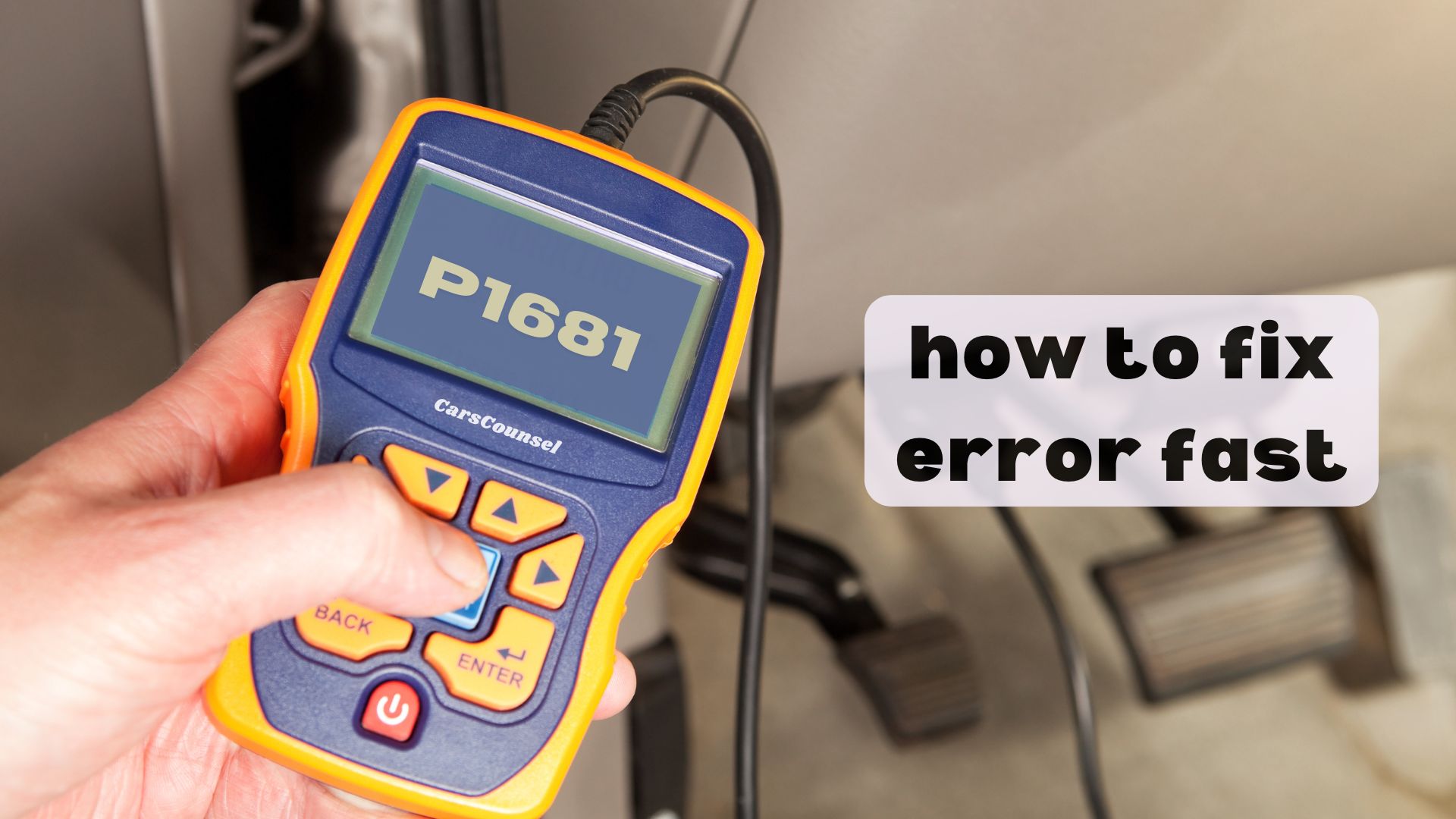Imagine you’re driving your car, and suddenly, the “check engine” light comes on. You take it to the mechanic, and they diagnose it with a P1681 code. This code indicates that the control module, the brain of your vehicle, hasn’t been programmed or configured correctly. This critical component manages various systems, including the engine, transmission, and emissions control. Without proper programming, you might experience decreased fuel efficiency, poor engine performance, and even safety hazards. But what exactly caused this issue, and how can you fix it?

Quick Navigation
Key Takeaways
- The P1681 code indicates that the control module hasn’t been programmed or configured correctly, affecting vehicle performance and efficiency.
- Faulty installations, software glitches, electrical issues, and improper software updates can trigger the P1681 code.
- Symptoms include the Check Engine Light, engine stalling, reduced power, and transmission issues, which can impact vehicle safety and performance.
- To fix the P1681 code, retrieve the vehicle history, scan the control module, inspect wiring and connections, and perform a software update if necessary.
- Repair costs range from $100 to $500, and consulting a professional mechanic or dealership is recommended to ensure a correct and safe repair.
What Does the P1681 Code Mean?
When your vehicle’s onboard computer generates a P1681 code, it’s a clear indication that the control module hasn’t been programmed or configured correctly.
This critical component manages various systems, including the engine, transmission, and emissions control. Without proper programming, you can expect issues with vehicle performance, efficiency, and overall functionality.
You may notice decreased fuel efficiency, poor engine performance, and potential safety hazards. It’s essential to address this issue promptly to prevent further damage and guarantee your vehicle operates smoothly and safely.
Common Causes of the P1681 Code
The P1681 code can arise from a variety of sources, and pinpointing the root cause is crucial to effective repair.
You’ll need to investigate the programming process, as faulty installations or software glitches can trigger this code. Check if the control module was programmed correctly during installation or software updates.
Electrical issues with wiring or connections to the control module can also be a culprit. Additionally, software update failures or improper installation of aftermarket components can lead to the P1681 code.
Symptoms of the P1681 Code
Your vehicle’s performance will likely exhibit some telltale signs when the control module isn’t programmed correctly, triggering the P1681 code.
You may notice the Check Engine Light illuminating on your dashboard, indicating a problem.
Engine stalling or difficulty starting are common symptoms, along with reduced power or sluggish acceleration.
Your vehicle’s fuel efficiency may also suffer, and you might experience transmission issues like shifting problems or erratic behavior.
These signs can significantly impact your vehicle’s performance, making it essential to address the issue promptly to prevent further damage.
How to Fix the P1681 Code
To get your vehicle running smoothly again, you’ll need to tackle the P1681 code head-on.
Start by retrieving your vehicle history to identify any previous programming issues or software updates.
Next, use programming tools to scan the control module and pinpoint the cause of the error.
Inspect the wiring harness and connections to the control module for damage or loose connections.
If necessary, perform a software update to the latest version.
Reprogramming the Control Module
Reprogramming the control module requires specialized tools and a clear understanding of the process to avoid further complications.
You’ll need to perform a Module Reset to erase any existing programming errors. Then, use the correct software and settings to reprogram the module.
Be cautious, as Programming Errors can lead to additional issues. Guarantee you have the latest software version and follow the manufacturer’s guidelines to avoid mistakes.
Take your time, and carefully enter the correct parameters to avoid introducing new problems. Verify you have double-checked all steps to prevent oversights.
A successful reprogramming will resolve the P1681 code and get your vehicle running smoothly again.
Inspecting and Repairing Electrical Connections
Electrical connections play a pivotal role in the control module‘s ability to function correctly, and inspecting them is a key step in resolving the P1681 code.
You’ll need to examine the wiring harness and connections to the control module for signs of damage, corrosion, or loose connections. Check for electrical surges that may have caused damage to the wiring or connections.
Make any necessary repairs, guaranteeing all connections are secure and free of corrosion. This will help prevent further electrical issues and verify the control module can function correctly once reprogrammed.
Performing a Software Update
Performing a software update is a crucial step in resolving the P1681 code, as it verifies the control module has the latest settings and configurations.
You’ll need to identify the correct software version for your vehicle’s make and model. Update methods may vary depending on the manufacturer’s guidelines, so be sure to follow their instructions.
Common update methods include using a scan tool, downloading software from the manufacturer’s website, or visiting a dealership. Certify you’re using a trustworthy source to avoid introducing software issues.
A successful update will resolve any software-related problems causing the P1681 code.
Cost and Importance of Repairing the P1681 Code
After verifying your vehicle’s control module has the latest software, you’ll want to weigh the cost and importance of repairing the P1681 code. The repair cost estimates range from $100 to $500, including parts and labor. However, the actual cost may be higher if additional components need to be replaced or if the control module is faulty.
| Repair Priority | Cost Estimate | Repair Difficulty |
|---|---|---|
| High | $100-$500 | Hard |
| Medium | $50-$200 | Medium |
| Low | $20-$100 | Easy |
Considering the potential safety hazards and performance issues, repairing the P1681 code should be a high priority. Consult a professional mechanic or dealership for an accurate cost estimate and to guarantee the repair is done correctly.
More OBD-II Codes
| P1117 | P1685 | P1686 | P1687 |
| P1688 | P1689 | P1691 | P1695 |
| P1155 | P1156 | P1157 | P1158 |
| P1159 | P1161 | P1163 | P1164 |
| P1165 | P1170 | P1171 | P1185 |
| P1189 | P1187 | P1190 | P1215 |
Frequently Asked Questions
Can I Drive My Vehicle With the P1681 Code?
You shouldn’t drive your vehicle with the P1681 code, as it can compromise vehicle safety and lead to failing roadworthiness tests; instead, address the issue promptly to prevent further damage and guarantee your safety on the road.
Will the P1681 Code Cause Permanent Engine Damage?
Your engine’s performance is like a conductor leading an orchestra, and programming errors can be the discordant note that throws everything off; if left unchecked, it can cause permanent damage, but prompt reprogramming can harmonize your engine’s performance once again.
Can a Faulty Oxygen Sensor Trigger the P1681 Code?
You won’t typically see a faulty oxygen sensor trigger the P1681 code, as it’s related to the control module’s programming. However, a faulty sensor might cause issues that lead to a software update, which, if done incorrectly, could trigger the P1681 code, requiring sensor replacement and a proper calibration process.
Will a Tune-Up or Oil Change Fix the P1681 Code?
When you’re wondering if a tune-up or oil change will fix the issue, think of it like trying to put new shoes on a car with a faulty GPS – it won’t get you where you need to go. You’ll need a diagnostic scan tool to identify the root cause, and a vehicle history check to guarantee proper programming.
Can I Reset the P1681 Code Without Repairing the Issue?
You cannot simply reset the code without repairing the underlying issue; a code reset won’t fix the problem, and a module reflash may be required to reprogram the control module with correct software and settings.
Conclusion
You’ve finally cracked the code – literally! The P1681 code is more than just a pesky error message; it’s a warning sign that your vehicle’s control module needs attention. By reprogramming, inspecting connections, and updating software, you’ll be back on the road in no time. Remember, a stitch in time saves nine – or in this case, a well-programmed control module saves fuel, performance, and safety. Get it fixed, and you’ll be driving like a boss in the 21st century!

